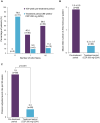Reduction of anterior uveitis flares in patients with axial spondyloarthritis on certolizumab pegol treatment: final 2-year results from the multicenter phase IV C-VIEW study
- PMID: 33854572
- PMCID: PMC8010825
- DOI: 10.1177/1759720X211003803
Reduction of anterior uveitis flares in patients with axial spondyloarthritis on certolizumab pegol treatment: final 2-year results from the multicenter phase IV C-VIEW study
Abstract
Introduction: Acute anterior uveitis (AAU), affecting up to 40% of patients with axial spondyloarthritis (axSpA), risks permanent visual deficits if not adequately treated. We report 2-year results from C-VIEW, the first study to prospectively investigate certolizumab pegol (CZP) on AAU in patients with active axSpA at high risk of recurrent AAU.
Patients and methods: C-VIEW (NCT03020992) was a 104-week (96 weeks plus 8-week safety follow-up), open-label, multicenter study. Eligible patients had active axSpA, human leukocyte antigen-B27 (HLA-B27) positivity and a history of recurrent AAU (⩾2 AAU flares in total; ⩾1 in the year prior to baseline). Patients received CZP 400 mg at weeks 0, 2 and 4, then 200 mg every 2 weeks to week 96. The primary efficacy endpoint was the AAU flare event rate during 96 weeks' CZP versus 2 years pre-baseline.
Results: Of 115 enrolled patients, 89 initiated CZP (male: 63%; radiographic/non-radiographic axSpA: 85%/15%; mean disease duration: 9.1 years); 83 completed week 96. There was a significant 82% reduction in AAU flare event rate during CZP versus pre-baseline [rate ratio (95% confidence interval): 0.18 (0.12-0.28), p < 0.001]. One hundred percent and 59.6% of patients experienced ⩾1 and ⩾2 AAU flares pre-baseline, respectively, compared to 20.2% and 11.2% during treatment. Age, sex and axSpA population subgroup analyses were consistent with the primary analysis. There were substantial improvements in axSpA disease activity with no new safety signal identified.
Conclusion: CZP treatment significantly reduced AAU flare event rate in patients with axSpA and a history of AAU, indicating CZP is a suitable treatment option for patients at risk of recurrent AAU.
Trial registration clinicaltrialsgov: NCT03020992, URL: https://clinicaltrials.gov/ct2/show/NCT03020992.
Keywords: TNF inhibitor; axial spondyloarthritis; extra-articular manifestations; uveitis.
© The Author(s), 2021.
Conflict of interest statement
Conflict of interest statement: Irene E. van der Horst-Bruinsma: Honoraria/consulting fees/research grants from AbbVie, BMS, MSD, Novartis, Pfizer, UCB Pharma; Rianne E. van Bentum: none; Frank D. Verbraak: Honoraria/consulting fees/research grants from Bayer, Novartis, IDxDR, UCB Pharma; Atul Deodhar: Honoraria/consulting fees/research grants from AbbVie, Amgen, Boehringer Ingelheim, BMS, Eli Lilly, GSK, Janssen, Novartis, Pfizer, UCB Pharma; Thomas Rath: Honoraria/consulting fees from AbbVie, BMS, Chugai, Eli Lilly, MSD, Novartis, Pfizer, Roche, UCB Pharma; Bengt Hoepken, Oscar Irvin-Sellers, Lars Bauer: Employees of UCB Pharma; Karen Thomas: Former contractor with UCB Pharma; Martin Rudwaleit: Honoraria/consulting fees from AbbVie, BMS, Celgene, Eli Lilly, Janssen, MSD, Novartis, Pfizer, Roche, UCB Pharma.
Figures



Similar articles
-
Certolizumab Pegol Treatment in Patients with Axial-Spondyloarthritis-Associated Acute Anterior Uveitis: a Narrative Review.Rheumatol Ther. 2022 Dec;9(6):1481-1497. doi: 10.1007/s40744-022-00486-1. Epub 2022 Sep 30. Rheumatol Ther. 2022. PMID: 36178585 Free PMC article. Review.
-
The impact of certolizumab pegol treatment on the incidence of anterior uveitis flares in patients with axial spondyloarthritis: 48-week interim results from C-VIEW.RMD Open. 2020 Apr;6(1):e001161. doi: 10.1136/rmdopen-2019-001161. RMD Open. 2020. PMID: 32371433 Free PMC article. Clinical Trial.
-
Predictors of long-term clinical response in patients with non-radiographic axial spondyloarthritis receiving certolizumab pegol.Arthritis Res Ther. 2021 Oct 29;23(1):274. doi: 10.1186/s13075-021-02650-4. Arthritis Res Ther. 2021. PMID: 34715908 Free PMC article. Clinical Trial.
-
Induction of Sustained Clinical Remission in Early Axial Spondyloarthritis Following Certolizumab Pegol Treatment: 48-Week Outcomes from C-OPTIMISE.Rheumatol Ther. 2020 Sep;7(3):581-599. doi: 10.1007/s40744-020-00214-7. Epub 2020 Jun 11. Rheumatol Ther. 2020. PMID: 32529495 Free PMC article.
-
Spotlight on certolizumab pegol in the treatment of axial spondyloarthritis: efficacy, safety and place in therapy.Open Access Rheumatol. 2018 May 7;10:33-41. doi: 10.2147/OARRR.S116654. eCollection 2018. Open Access Rheumatol. 2018. PMID: 29765257 Free PMC article. Review.
Cited by
-
Development of Extramusculoskeletal Manifestations in Upadacitinib-Treated Patients With Psoriatic Arthritis or Axial Spondyloarthritis.Arthritis Rheumatol. 2025 May;77(5):536-546. doi: 10.1002/art.43069. Epub 2025 Jan 24. Arthritis Rheumatol. 2025. PMID: 39624020 Free PMC article.
-
Low uveitis rates in patients with axial spondyloarthritis treated with bimekizumab: pooled results from phase 2b/3 trials.Ann Rheum Dis. 2024 Nov 14;83(12):1722-1730. doi: 10.1136/ard-2024-225933. Ann Rheum Dis. 2024. PMID: 38977276 Free PMC article.
-
The management of adult and paediatric uveitis for rheumatologists.Nat Rev Rheumatol. 2024 Dec;20(12):795-808. doi: 10.1038/s41584-024-01181-x. Epub 2024 Nov 6. Nat Rev Rheumatol. 2024. PMID: 39506056 Review.
-
Certolizumab Pegol Treatment in Patients with Axial-Spondyloarthritis-Associated Acute Anterior Uveitis: a Narrative Review.Rheumatol Ther. 2022 Dec;9(6):1481-1497. doi: 10.1007/s40744-022-00486-1. Epub 2022 Sep 30. Rheumatol Ther. 2022. PMID: 36178585 Free PMC article. Review.
-
A review on anterior uveitis and spondyloarthritis with a focus on the interdisciplinary approach between ophthalmologists and rheumatologists.Saudi J Ophthalmol. 2025 Jan 2;39(1):20-30. doi: 10.4103/sjopt.sjopt_240_24. eCollection 2025 Jan-Mar. Saudi J Ophthalmol. 2025. PMID: 40182969 Free PMC article.
References
-
- Bacchiega ABS, Balbi GGM, Ochtrop MLG, et al.. Ocular involvement in patients with spondyloarthritis. Rheumatology (Oxford) 2017; 56: 2060–2067. - PubMed
-
- Rosenbaum JT, Smith JR. Anti-TNF therapy for eye involvement in spondyloarthropathy. Clin Exp Rheumatol 2002; 20: S143–S145. - PubMed
-
- Frantz C, Portier A, Etcheto A, et al.. Acute anterior uveitis in spondyloarthritis: a monocentric study of 301 patients. Clin Exp Rheumatol 2019; 37: 26–31. - PubMed
Associated data
LinkOut - more resources
Full Text Sources
Other Literature Sources
Medical
Research Materials

